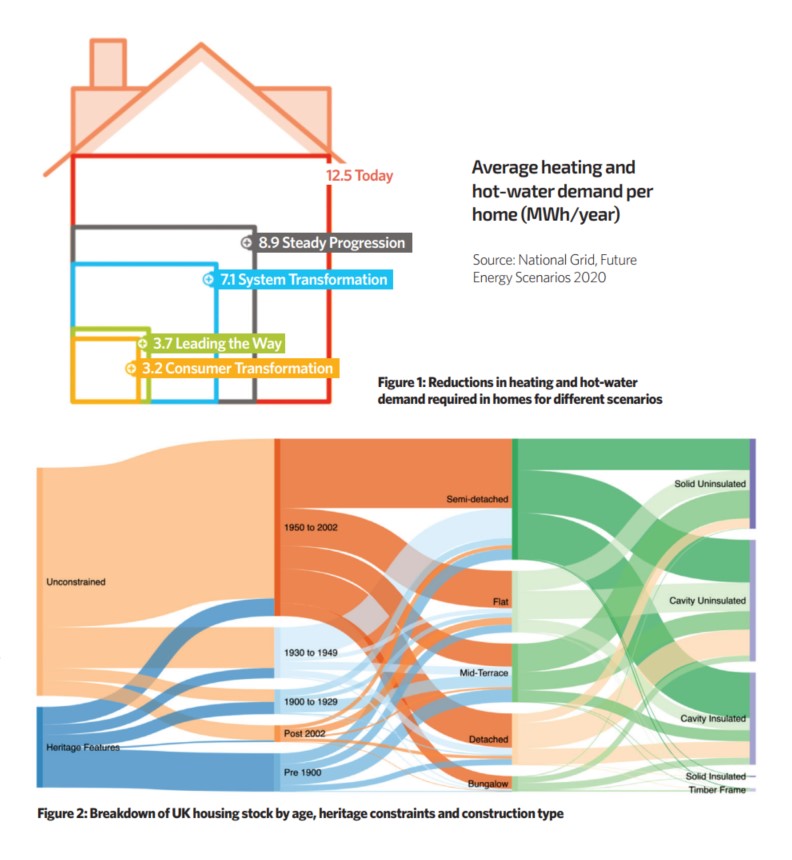
Retrofit and refurbishment – difficult, expensive, messy. Do we really need to do this? Maybe we can get away with a bit more loft insulation, turn our thermostats down by a degree and fit some heat pumps. Wouldn’t that be good enough?
The problem is, our homes in the UK are some of the oldest in Europe, so are poorly insulated and draughty. Overall, they use 480TWh of energy annually, with the vast majority of this being thermal energy for heating and hot water, provided by natural gas. This is a huge amount of heat and much of it is wasted. In a net-zero future, we simply won’t be able to combust all that natural gas to produce heat.
So, what does our future net-zero building look like? This is a complicated question, but – looking at operational emissions only – we need to match the energy use associated with the building with the same amount of renewable energy. The generation of this renewable energy doesn’t necessarily need to happen within the footprint of the building, but it needs to happen somewhere – we can’t just hope that there’s enough out there to make it all work.
And this is where it gets interesting. Renewable energy is almost infinite – enough solar energy reaches Earth every hour to power humanity for a year. Similarly, there is 40 times more wind energy in the atmosphere than our current global energy use. However, the practicalities of deploying technologies to harvest this energy mean that it is actually finite. Wind farms, solar arrays and tidal barrages cost money, result in their own embodied carbon emissions and will, typically, need to be replaced every 20 years.
How much renewable energy we will have is difficult to predict – it depends heavily on future government policy and long-term investment. The most optimistic figures from the National Grid’s Future Energy Scenarios, however, are showing that we might have around 580TWh of renewable generation by 2050. That’s a lot of energy – but it will also, by that point, be our main source of energy.
This means that all sectors – industry, transport, agriculture and buildings – will want their fair share of renewable energy. As we move our buildings away from natural gas to electrified heating, the National Grid’s figures show that we will need to reduce the thermal energy demand of our homes by up to 75% to make the demand-v-supply equation balance (see Figure 1).
That’s a big change. Just to put it into context, adding 300mm of loft insulation to a previously uninsulated loft will result in only a 7% reduction in heat demand. There is some good news, in that we will get a significant reduction from the coefficient of performance that heat pumps offer. However, this won’t get us all the way – and we need to remember that heat pumps will only be viable in most of our existing homes if the building’s fabric is upgraded to reduce the heat demand to a level that can be delivered at the lower flow temperatures needed by heat pumps to work efficiently.
But what about hydrogen? Surely a re-purposed gas grid and hydrogen boilers in every home would mean we can carry on being as wasteful as before and not bother trying to reduce demand?
The guidance will set out a target for a series of building types, alongside some practical guidance about how to achieve a best practice retrofit
Whether hydrogen could become the primary energy supply for domestic buildings is a big question. One way of doing this would be to produce hydrogen from natural gas and capture the associated carbon emissions. Carbon capture at scale is not yet proven, however, and would be a massive infrastructure project. We would also still be using a finite fossil fuel.
Alternatively, we could produce hydrogen using hydrolysis powered by renewable energy – but this is five to six times less efficient than simply using the same renewable energy to power heat pumps directly. Even the National Grid’s hydrogen-heavy scenario (System Transformation) shows that residential thermal energy demand would need to almost halve. Put simply, even if you think hydrogen is the answer, it is still a finite resource and you need to reduce thermal demand for the numbers to work.

It would seem clear that we need to reduce the energy demand of our homes significantly to make a net-zero future viable – but how far do we go? For some buildings, a 75% or more reduction in energy consumption might be feasible. For others, however, it will be much more difficult. Many of our buildings have heritage aspects that will constrain what we can achieve. So, what is realistic, and what should we be aiming for with a particular type of building?
The LETI retrofit group has been looking at this over the past year and is intending to publish some guidance early in 2021. We have looked at the UK housing stock and at what a good retrofit might look like. Despite the vast amount of complexity and different housing types, the end result would appear to be determined by just three factors – the form/shape of the building, the construction type, and whether the external appearance of the building is constrained (see Figure 2).
Using this methodology, the guidance will set out a kWh.m-2 per year energy use intensity (EUI) target for a series of building types, alongside some practical guidance about how to achieve a best-practice retrofit, and illustrated by several real-world exemplar case studies.
Rather than carry on hoping that a bit of loft insulation will be enough, LETI hopes that this guidance will provide industry professionals with some tangible evidence of what is possible and some clear targets to support a net-zero future.
■ John Palmer is research and policy director at the Passivhaus Trust and leading the LETI retrofit workstream
